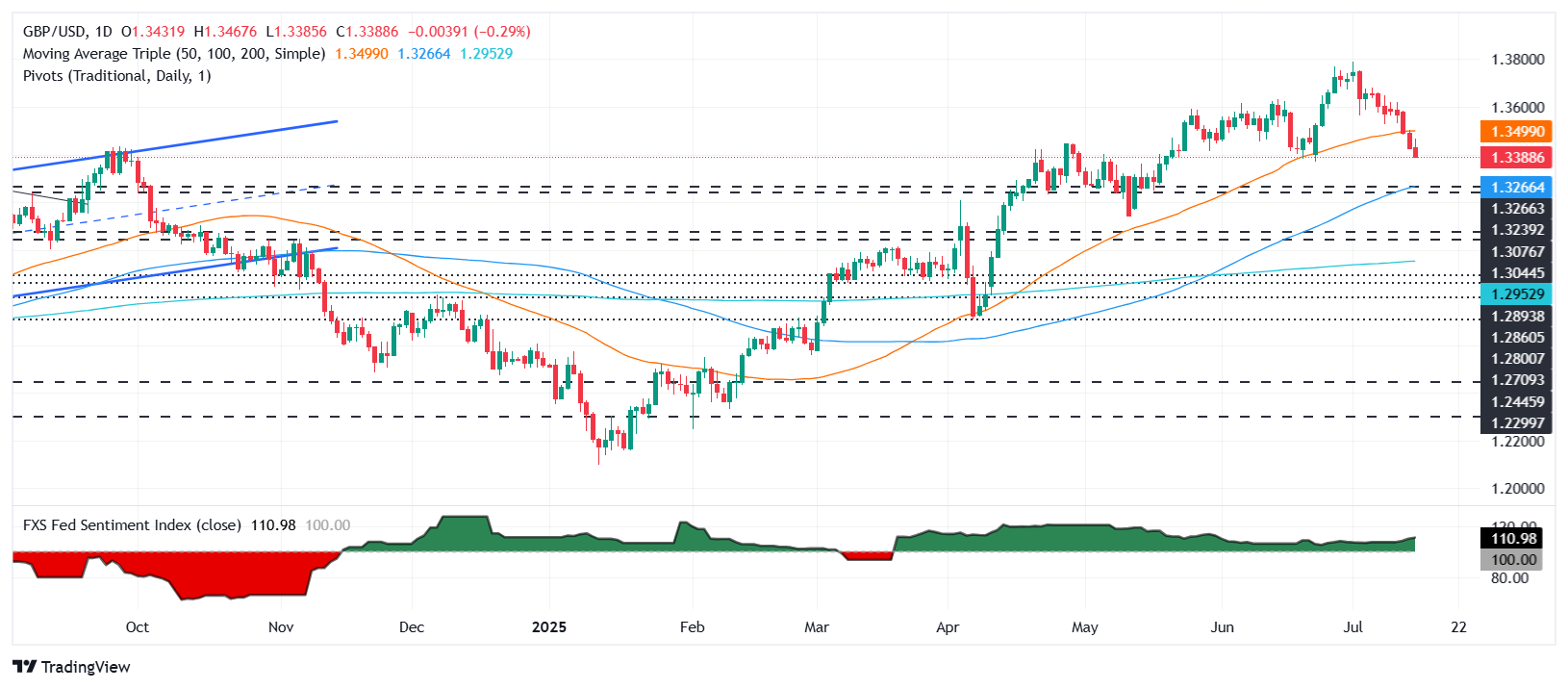Created
: 2025.07.16














![]() 2025.07.16 00:53
2025.07.16 00:53
The GBP/USD extended its losses to four consecutive days after the latest inflation report in the United States (US) showed signs of rising, the first indication that tariffs triggered a jump in prices. At the time of writing, the pair trades below 1.3400, down by 0.23%.
The US Bureau of Labor Statistics (BLS) revealed that the Consumer Price Index (CPI) for June increased the most in five months, rose by 2.7% YoY, exceeding estimates of 2.6% and May's 2.4% rise. Excluding volatile items like food and energy, the so-called core CPI increased by 2.9% YoY, up from 2.8% achieved in three straight months but below forecasts of 3%.
The data further reinforced the Federal Reserve's stance to hold rates unchanged at least for the July meeting. Traders are still pricing in over 43 basis points of easing toward the year's end, according to data from the Chicago Board of Trade (CBOT).
The US Dollar Index (DXY), which tracks the value of the Dollar against six major currencies, is up 0.46% at 98.55. US Treasury yields are also up, with the 10-year note yielding 4.475% nearly four basis points up.
Across the pond, the UK economic docket is scarce. Nevertheless, last week's UK GDP report revealed that the economy unexpectedly contracted for the second consecutive month, exerting pressure on the Bank of England (BoE) to deliver interest rate cuts towards the end of the year.
Money markets show traders expect two rate cuts to the Bank Rate, from 4.25% to 3.75%.
The US economic docket will feature the Producer Price Index (PPI) and Retail Sales data. In the UK, the calendar will feature CPI for June, which is expected to remain unchanged, with headline inflation at 3.4% and core CPI at 3.5%.
In the near term, the GBP/USD is neutral to downward biased as the pair aims to challenge the first support, seen at 1.3369, the June 23 cycle low. If breached, the next support is 1.3300, followed by the 100-day SMA at 1.3263.
The Relative Strength Index (RSI) indicates that sellers have continued to gain momentum, suggesting further downside is expected.
For a bullish continuation, the GBP/USD must climb past the 50-day SMA at 1.3495.

The Pound Sterling (GBP) is the oldest currency in the world (886 AD) and the official currency of the United Kingdom. It is the fourth most traded unit for foreign exchange (FX) in the world, accounting for 12% of all transactions, averaging $630 billion a day, according to 2022 data. Its key trading pairs are GBP/USD, also known as 'Cable', which accounts for 11% of FX, GBP/JPY, or the 'Dragon' as it is known by traders (3%), and EUR/GBP (2%). The Pound Sterling is issued by the Bank of England (BoE).
The single most important factor influencing the value of the Pound Sterling is monetary policy decided by the Bank of England. The BoE bases its decisions on whether it has achieved its primary goal of "price stability" - a steady inflation rate of around 2%. Its primary tool for achieving this is the adjustment of interest rates. When inflation is too high, the BoE will try to rein it in by raising interest rates, making it more expensive for people and businesses to access credit. This is generally positive for GBP, as higher interest rates make the UK a more attractive place for global investors to park their money. When inflation falls too low it is a sign economic growth is slowing. In this scenario, the BoE will consider lowering interest rates to cheapen credit so businesses will borrow more to invest in growth-generating projects.
Data releases gauge the health of the economy and can impact the value of the Pound Sterling. Indicators such as GDP, Manufacturing and Services PMIs, and employment can all influence the direction of the GBP. A strong economy is good for Sterling. Not only does it attract more foreign investment but it may encourage the BoE to put up interest rates, which will directly strengthen GBP. Otherwise, if economic data is weak, the Pound Sterling is likely to fall.
Another significant data release for the Pound Sterling is the Trade Balance. This indicator measures the difference between what a country earns from its exports and what it spends on imports over a given period. If a country produces highly sought-after exports, its currency will benefit purely from the extra demand created from foreign buyers seeking to purchase these goods. Therefore, a positive net Trade Balance strengthens a currency and vice versa for a negative balance.
![]()
Created
: 2025.07.16
![]()
Last updated
: 2025.07.16

FXStreet is a forex information website, delivering market analysis and news articles 24/7.
It features a number of articles contributed by well-known analysts, in addition to the ones by its editorial team.
Founded in 2000 by Francesc Riverola, a Spanish economist, it has grown to become a world-renowned information website.
We hope you find this article useful. Any comments or suggestions will be greatly appreciated.
We are also looking for writers with extensive experience in forex and crypto to join us.
please contact us at [email protected].
Disclaimer:
All information and content provided on this website is provided for informational purposes only and is not intended to solicit any investment. Although all efforts are made in order to ensure that the information is correct, no guarantee is provided for the accuracy of any content on this website. Any decision made shall be the responsibility of the investor and Myforex does not take any responsibility whatsoever regarding the use of any information provided herein.
The content provided on this website belongs to Myforex and, where stated, the relevant licensors. All rights are reserved by Myforex and the relevant licensors, and no content of this website, whether in full or in part, shall be copied or displayed elsewhere without the explicit written permission of the relevant copyright holder. If you wish to use any part of the content provided on this website, please ensure that you contact Myforex.
Myforex uses cookies to improve the convenience and functionality of this website. This website may include cookies not only by us but also by third parties (advertisers, log analysts, etc.) for the purpose of tracking the activities of users. Cookie policy